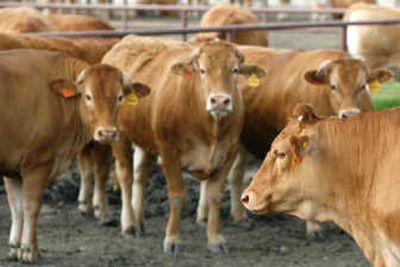Kobe comes to Texas

HARWOOD, Texas — Even by the standards of Texas — where beef is no trivial matter — rancher Jose Antonio Elias Calles has coddled his cattle.
The animals imported from Japan are guarded by off-duty Texas Rangers and kept away from American bulls that might contaminate their coveted gene pool. They were meticulously reared for 12 years before a single hamburger could be sold.
“We knew it was going to take a long time,” said Calles, whose interest in ranching was sparked by a grandfather who raised cattle for export in northern Mexico.
Japanese cattle, which come in red and black varieties, are a closely guarded national treasure. Their beef, often called “Kobe beef” by American restaurants, commands staggering prices but is heralded by chefs and foodies for thoroughly marbled fat that gives the meat tenderness and rich flavor. On a 0-12 quality scale used to rate beef in Japan, where heavy fat marbling is preferred, Kobe rates a minimum nine points and Angus beef 4.5; Calles’ animals rate around 7.5 to 8.5.
Through careful breeding and with the help of surrogate cows, Calles’s tiny herd of 11 has grown to 5,000, the largest group of purebred Akaushi cattle outside Japan.
A number of American producers sell beef from half-breed Japanese cattle, but Calles’ company, HeartBrand Beef, now has enough animals grazing in south Texas to market purebred American-raised Japanese beef to restaurants and consumers.
The butterscotch-colored cattle are genetically identical to those raised by Japanese ranchers, Calles said. They aren’t as fatty as the highest-quality Japanese beef but only because of the tastes of health-conscious American diners.
Calles and his investors acquired their tiny original group of Akaushi after an exporter flew the animals on an airliner to the United States in 1994. They had been sitting in quarantine in Japan for two years while Japanese trade officials tried to sort out how a trade agreement loophole resulted in the legal export of the animals from Japan.
“It was really just a miracle that it worked this way,” said Calles. “Some of the best animals came to here.”
Since that time, Calles and his business partners, who paid $2.5 million for the original herd and millions more to get a marketable quantity of purebred beef, have been growing it large and steady enough to offer roughly 15,000 pounds of beef per week. Because reproduction rates in cattle are low, Calles had purebred embryos implanted in surrogate cows, preserving the genetic material of the Japanese animals but allowing for faster reproduction.
Today, herds of identical-looking red Japanese cattle graze on tall grass at HeartBrand’s ranch and other nearby properties before being taken to feedlots, where they are given more-than-average shade and space during their final weeks before slaughter.
On the market since last year, HeartBrand distributes to about 40 restaurants and a handful of retailers.
American beef consumption has been declining over the last 25 years, but producers like HeartBrand and others with crossbred animals can command premium prices for their boutique beef.
“The interest in Wagyu (Japanese cows) is growing rapidly,” said David Lunt, who has spent decades researching Japanese cattle and is the associate head for operations at Texas A&M University’s animal science department.
Choice grade ground beef — the kind pickier Americans will buy from supermarkets for July 4 barbecues — sold for an average $3.97 per pound last year, according to the National Cattlemen’s Beef Association. HeartBrand’s ground beef sells for $6 per pound, while a 12-ounce ribeye goes for $45, a cost that at least partially reflects the expense of caring for the animals. “This is a beef that’s eaten on special occasions,” Lunt said.
The rich price tag helps give the meat a cachet and drives demand, he said. And because it’s seen as an occasional luxury, diners are less likely to worry about the overall fat content.
“It’s like if you go into a Rolls Royce dealership, I promise you they’re not going to brag to you about the gas mileage,” Lunt said.
Charles Gaskins, a member of the American Wagyu Association board, said chefs have known about Japanese cattle for years, but because of the expense of importing the meat, American alternatives have become popular.